Instagram Reels Pricing: Know Your Worth as a Creator
Everything you need to price, negotiate, and protect yourself in brand deals — with real tips, scripts, and contract basics.
August 26, 2025
August 26, 2025
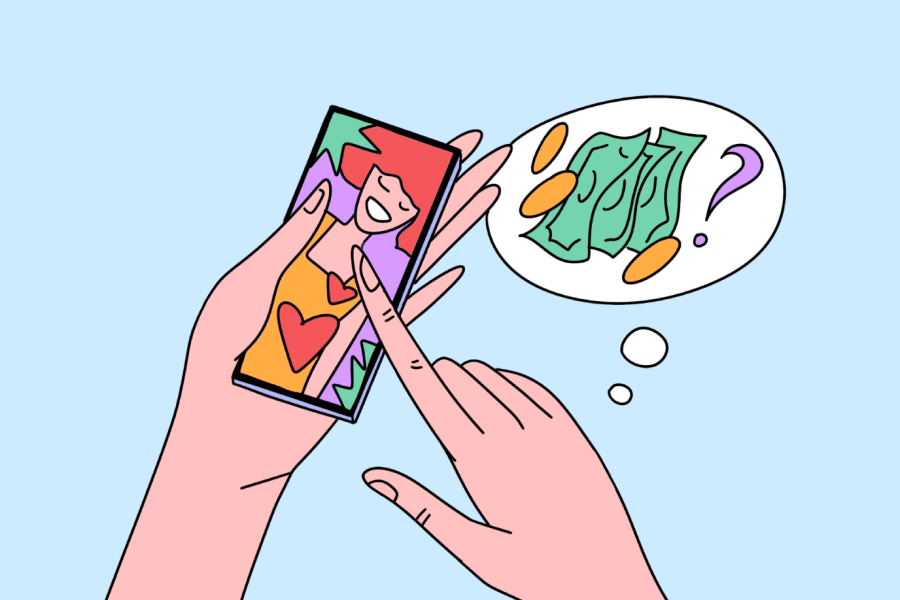
Key points:
- Reels are king in 2025. They outperform all other post types on Instagram in terms of reach and engagement, which makes them extremely valuable to brands.
- Rates aren’t universal. Your pricing should reflect your follower engagement, production effort, niche, and usage rights, not just your follower count.
- A clear rate card saves time. Listing your services, deliverables, and add-ons upfront helps you negotiate confidently and professionally.
- Contracts and boundaries protect you. Always use contracts, charge for extras like revisions and boosting, and don’t be afraid to walk away from shady offers.
If you’re creating short videos for clients or brands, you’ve probably asked yourself: how much should I be charging for this? Whether you’re a freelance content creator, a small business owner dabbling in influencer marketing, or a micro-influencer getting your first sponsored posts — figuring out fair pricing for Instagram Reels can feel confusing.
There’s no blanket rate, but there are factors you can consider to set prices that reflect your time, effort, and reach. In this article, we’ll break down how much to charge for Instagram Reels depending on your audience size, content quality, and the type of collaboration.

Why Instagram reels are so valuable in 2025
I’m sure every Instagram user is familiar with the concept of Reels. Let’s recap it just in case: Instagram Reels are short-form vertical videos — typically 15 to 90 seconds long — designed for maximum discoverability. Think of them as Instagram’s answer to TikToks or YouTube Shorts: quick, catchy, algorithm-friendly, and often soundtracked by trending audio. Originally launched in 2020, Reels have become one of the most powerful content formats on the platform.
Short-form video dominates the content landscape
Love it or hate it (I’m personally firmly in the “hate” camp), short-form video is the internet in this day and age. Reels and other short-form videos are not just entertainment anymore; they’re how people learn, shop, get inspired, and decide what to buy next.
Let’s talk about Instagram specifically — according to research from Buffer, Reels see at least 36% more reach than other post types.
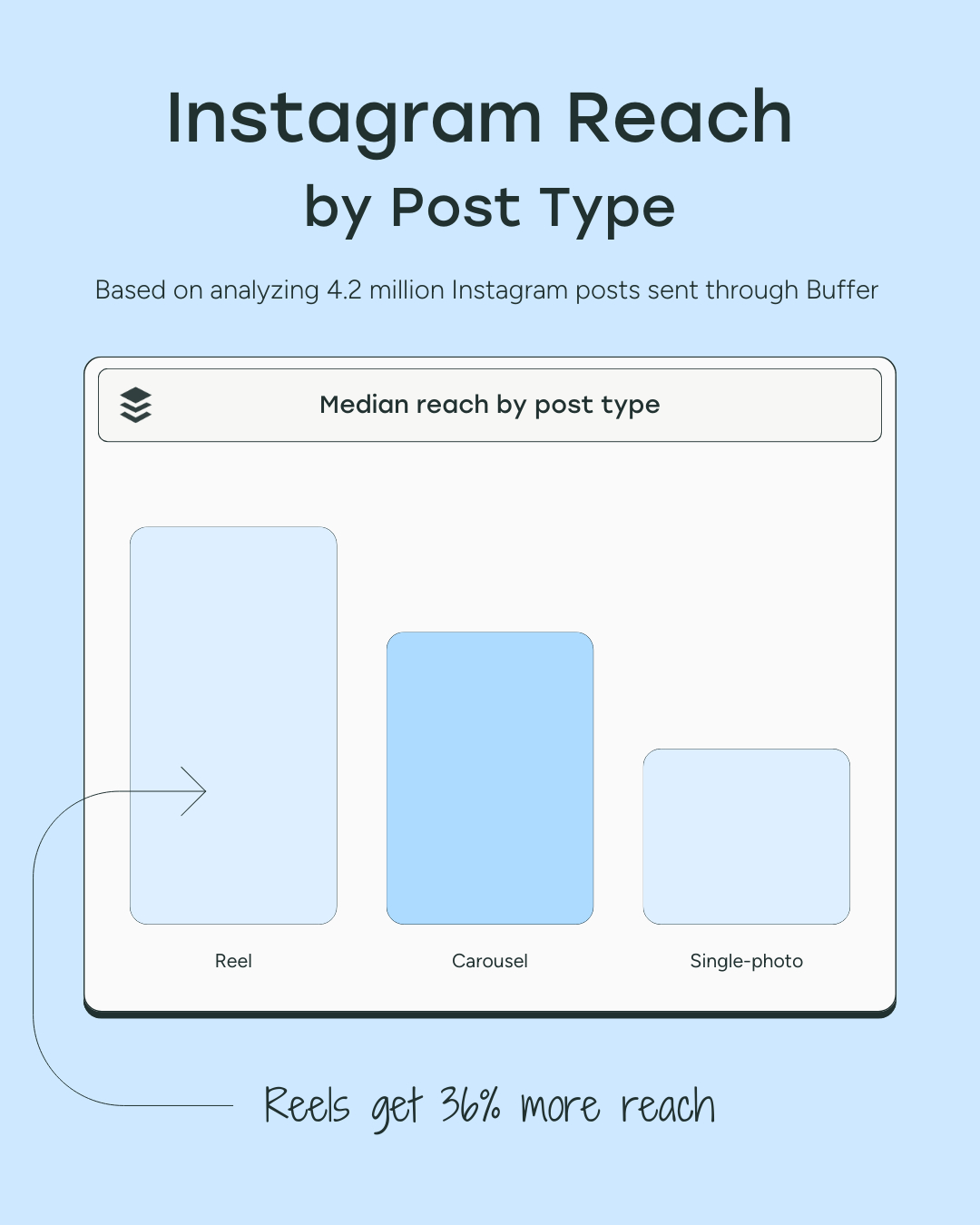
Unlike Stories or Feed posts, which are shown mostly to people who already follow you, Reels get their own dedicated tab and algorithm. The Reels feed is built to introduce users to new creators, not just show them content from friends and familiar brands. This means that:
- Reels are more likely to reach people who’ve never heard of you before
- Instagram is actively trying to serve your content to the right audiences
- Even one high-performing Reel can bring in thousands of new eyes.

Brand budgets for influencer marketing are at an all-time high
Influencer marketing is massive right now, and it doesn’t seem to be slowing down any time soon. According to a report by Influencer Marketing Hub, the influencer marketing industry has grown from just $1.4 billion in 2014 to an estimated $32.55 billion in 2025. That’s more than 23x growth in a decade, rising at an average of 33% per year.
Brands are investing more than ever into creators, especially on platforms like Instagram, where short-form video leads the way. The same report suggests that Instagram (used by 57.1% of marketers) and TikTok (51.6%) are the top platforms for influencer campaigns in 2025.
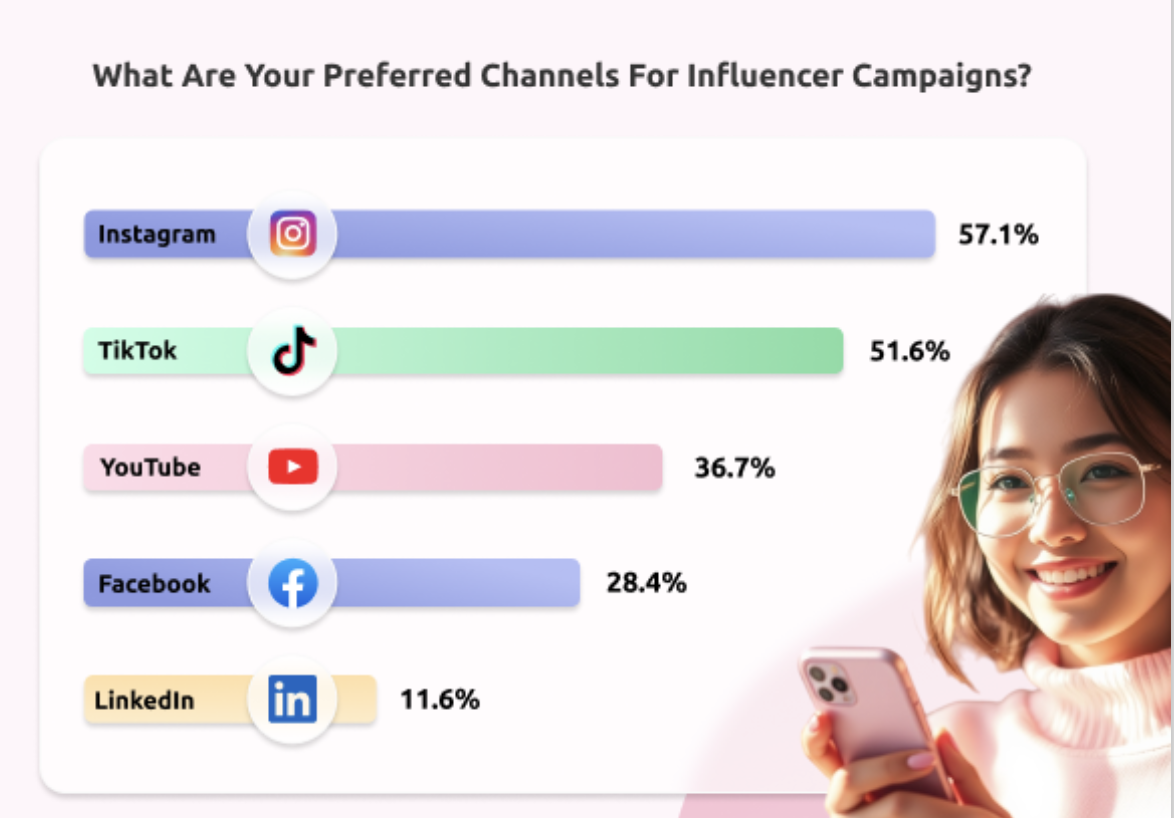
How much to charge for Instagram Reels (with examples)
So, reels are dominating the app, and brands are pouring money into creator partnerships. What does that mean for you as an influencer or a UGC creator? It means you should absolutely be charging for your work, and charging fairly.
In this section, we’ll break down how to price your Instagram reels, what pricing models exist, and what kind of fees real creators are charging in 2025. Let’s get into it.
Influencer marketing vs UGC: what’s the difference?
There are two main ways creators earn from working with brands, and only one of them involves posting on your own feed.
- Influencer marketing is what most people think of first: you create content and post it to your own account. You’re being paid for your reach, engagement, and creative style. The brand benefits from your audience seeing and trusting the content.
- UGC (user-generated content) means you create videos or photos for a brand, but you don’t post them yourself. The brand uses them in their own marketing: on their page, in paid ads, on their website. You’re being paid for your content creation skills, not your audience. Even if your account is small or niche, but you’re good at working with short-format video, UGC is a great way to get paid.
Common pricing models: flat fee, affiliate, bundles
There’s no one-size-fits-all way to charge for your Instagram Reels, but most creators fall into one of three pricing models: flat fee, affiliate commission, or bundled content packages.
Flat fee
This is the most straightforward model: the brand pays you a fixed amount to create and post a Reel on your page. You set your rate, negotiate deliverables, and (ideally) include usage rights, exclusivity, and revisions in your contract.
UGC can be priced with a flat fee, too, but in that case, you’re not posting it yourself.
Pros:
- Guaranteed income. You get paid regardless of how your post performs.
- Simple logistics. It’s easy to negotiate, invoice, and include in contracts.
Cons:
- No performance bonus. You won’t earn extra even if your post goes viral.
- Justifying rates. You may need to explain your value if you have a small following.
I once undercharged for a project that required multiple edits and usage rights. It reminded me how important it is to set clear boundaries and stand firm on pricing.
{{Ciara Strickland}}
Affiliate/performance-based
In this model, you earn a commission on every sale or lead generated from your Reel, usually tracked with a unique link or discount code. Some brands offer a base rate plus commission; others rely on commission alone.
Pros:
- Unlimited earning potential. The more sales you drive, the more you make.
- Long-term value. Can generate passive income from older content.
Cons:
- No guaranteed income. If nobody buys, you don’t get paid.
- High audience trust needed. Best suited for creators whose followers act on recommendations.
Bundles
If you’re creating a lot of content for a brand or working with them across platforms, bundling your services is a great way to increase your overall fee. An example of this could be creating one Reel and several stories.
This model also includes UGC, TikToks, behind-the-scenes shots, or non-posted content for paid ads.
I price usage, Stories, and boosting based on how long and where the content will live. I also offer add-on packages for things like swipe-ups, links, or voiceovers.
{{Ciara Strickland}}

Pros:
- Higher total rate. You can charge more for multiple deliverables.
- Efficient workflow. Shooting several pieces of content at once saves time.
Cons:
- More upfront work. Requires careful scoping and planning.
- More complex logistics. You’ll need to clearly define what’s included and justify the value to the brand.
When pricing add-ons, I usually take into consideration the extra work that's involved. Can I make content from what I've already created? Or do I need to make additional content? If more hours are involved, this will increase the add-on price. But I also like to make sure I can create a well-balanced package of deliverables and will add in Stories, which can be a really easy lift to increase the overall package rate. For boosting or usage, I aim for $500/30 days at a minimum. It's important to know that brands are making money off of our ads, and we don't always have final say on how the ads are crafted. I like to know where the ads are going and try to price them based on that as well.
{{Jessica Camerata}}
Sample Instagram Reel rates in 2025
The table below shows typical flat-fee rates for a single Instagram Reel posted to your own account, based on follower size, according to research by CreatorJet. These are averages for the United States; your actual rate should reflect production value, niche, and platform impact.
Don’t forget, though, not every deal is a flat fee. Some partnerships use affiliate or performance-based pricing. Others involve bundles that mix Reels, Stories, UGC, and more. Flat rates are a starting point, not a rulebook.
You might’ve heard the old “$100 per 10K followers” rule — but in 2025, that metric matters less and less. Niche, production quality, and audience trust are just as important. A creator with 20K engaged followers and high-quality content can easily out-earn someone with 200K passive scrollers. We’ll break down all the factors that influence pricing in the next section — but as an example: Jessica, a fashion and lifestyle creator, has just over 61,000 followers on Instagram, but charges more than the table above indicates.
Typically, I look to charge anywhere from $1,500 to $3,000 for an Instagram Reel. It all depends on the budget, the timeline, and the total scope of work. Knowing how much work goes into creating a Reel and also utilizing my platform has made me more confident in asking for more when negotiating. I also always aim high and hope to meet in the middle. I came to this price range based on where brands have met me before in terms of budget.
{{Jessica Camerata}}
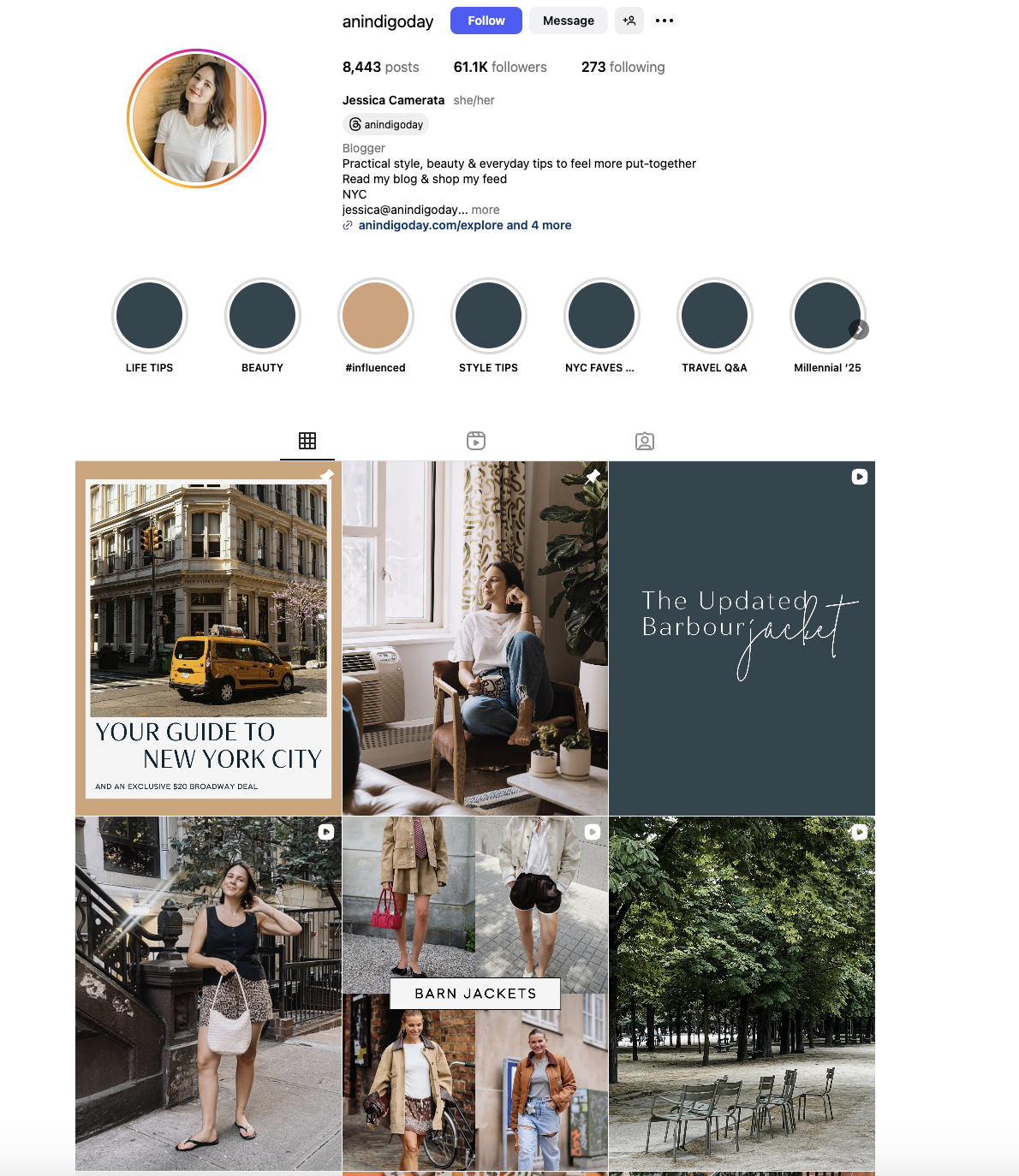
Key factors that affect your rates
Your ideal rate depends on more than just your follower count — brands look at a mix of data points and intangibles. Here’s what matters.
Follower count vs. engagement rate
Even if you don’t have hundreds of thousands of followers, that doesn’t mean you can’t earn money as a creator on Instagram. According to Influencer Marketing Hub, the majority of Instagram creators — over 75% — have between 1,000 and 10,000 followers, and many of them are not just posting for fun. They’re landing brand deals and building sustainable income streams, often with better engagement than accounts 10 times their size.
In 2024, nano-influencers had an average engagement rate of 1.73% — that’s miles ahead of the 0.6% range typical for mega and macro influencers. Brands love that kind of connection. For them, smaller creators mean more trust, more authenticity, and more bang for their buck.
Time for a bit of theory. So, what is engagement rate, exactly?
It’s a stat that tells a brand how well your audience actually interacts with your content — not just how many people follow you. There are two common ways to calculate it.
- By reach.
This version shows how many people who saw your content engaged with it. It’s especially useful when your content reaches far beyond your follower base (e.g., Reels, boosted posts).
Formula:
Engagement Rate = (Likes + Comments + Shares + Saves) ÷ Reach × 100
Let’s consider a practical example. Imagine you posted a Reel last week. You got 1,250 likes, 180 comments, 300 saves, and it reached 25,000 people.
Your engagement rate would be:
(1,250 + 180 + 300 + 270) ÷ 25,000 × 100 = 8%
That’s a very solid engagement rate.
- By followers.
This version shows how many of your actual followers engaged with your content. It’s often used when evaluating an account as a whole — for example, in media kits or brand negotiations.
Formula:
Engagement Rate = (Likes + Comments + Shares + Saves) ÷ Followers × 100
Let’s have a look at an example of this type of engagement rate as well. Imagine you have 10,000 followers. You post a Reel that gets 1,250 likes, 180 comments, 300 saves, and 270 shares.
Your engagement rate would be:
(1,250 + 180 + 300 + 270) ÷ 10,000 × 100 = 20%
That’s an excellent follower-based engagement rate.
Content quality, niche, and production effort
Not all posts are created equal. A casual iPhone snap and a carefully scripted, professionally lit Reel shouldn’t be priced the same, and most brands know that. They’re not just paying for a post; they’re paying for your eye, your editing, your tone of voice, and your ability to turn a brief into something that actually lands. The more thought, time, and effort you pour into the content, the more it’s worth.
I base my Reel rates on time, production value, and platform impact. I also factor in whether it's part of a larger campaign or a one-off collaboration.
{{Ciara Strickland}}
Another thing that matters is your niche. A travel creator who books hotels through affiliate links might earn differently from a food creator working with local restaurants, even if their follower count is the same.
Check out this video to get an idea of what niches are big on Instagram right now.
Creating a rate card that works for you
If you want to start monetising your content, having a clear, flexible rate card is essential. It’s not just a pricing list — it’s a communication tool. Your rate card helps brands understand what you offer, what it costs, and why you’re worth the investment. The goal here is to create a structure that reflects your value, covers your time and expenses, and leaves room to grow.
What to include in a clear rate card
Your rate card, which is a document that lists the prices for your services, doesn’t need to be fancy or overdesigned. It should be easy to read and answer a brand’s most common questions right away. Here’s what to include:
- Services you offer. Be specific: instead of just saying “Instagram post,” say “1 in-feed post with custom caption and 2 rounds of edits.” If you also do TikToks, newsletters, blog posts, or UGC, list those too.
- Rates for each deliverable. Add your standard price for each service. You can also include package deals, or note that rates are negotiable depending on scope and usage.
- What’s included. Clarify what’s part of the price — for example, is editing included? Will you reshoot if needed? Are reposts or exclusivity extra?
- Contact details. Include your phone number, your email, and links to your social media pages (obviously).
If you’re not a graphic design pro or just unsure how to get started, there are plenty of rate card templates you can find online. Here’s an example of a rate card:

Add-ons: stories, lives, rush fees, multi-post packages
Add-ons are anything that goes beyond your standard deliverables — things that take more of your time, increase a brand’s reach, or add urgency to the project. These are completely optional, but they’re also a great way to upsell and protect your time. Here are a few common ones to consider including on your rate card:
- Stories. A carousel of 3–5 slides, story-only mentions, or links with swipe-ups.
- Lives or livestreams. More time-consuming, more engaging, so they should come at a higher price.
- Rush fees. If the brand needs the post yesterday, you deserve to charge extra.
- Multi-post packages. Bundles for recurring content, like “1 reel + 2 stories a month” or “3 static posts over 3 months.”
You don’t have to list every add-on publicly, just know what you’re willing to offer and at what price.
Licensing, usage rights, and boosting fees
Just because a brand pays for a post doesn’t mean they automatically own it forever. If your content will be used beyond its original platform (or beyond a short window), you should charge extra. This protects your work and your earning potential. Here’s a breakdown:
- Usage rights cover how long and where the brand can republish your content (like on their website, in paid ads, in email campaigns). Common tiers are 3 months, 6 months, and 1 year.
- Full licensing or buyout gives the brand permanent, unrestricted rights to use your content. Charge accordingly — this is premium territory.
- Whitelisting (also known as boosting) is when a brand asks to run paid ads using your social media account, usually through Meta’s Branded Content Tools. Because the ad uses your face, your profile, and your audience’s trust, even though the brand is paying for it, boosted content often performs better than regular ads, which is exactly why you should charge for that access.
A quick note on copyright: by default, you, the creator, hold the copyright to your content, even if a brand pays you to post it. That means they can’t legally reuse it elsewhere unless you give them permission. If a brand wants to own the content outright, that’s a big deal. Check out our guide on copyright for freelancers.
Negotiating sponsored content like a pro
You’ve sent the rate card, the brand is interested: it’s time to negotiate. Whether you’re chatting over email or DMs, this part can feel awkward, but it doesn’t have to be.
Building a portfolio from scratch
If you’re just getting started, don’t stress if your rate card isn’t stacked with big numbers yet. Many creators begin by taking on low-paid (or even unpaid) partnerships. This isn’t because their work has no value, but to build a track record. Think of it as an investment: the goal is to build up performance examples, learn how to communicate with brands, and create content you can show to future clients.
Make sure you have a professional account, optimise your bio (like adding a clear description of what you do, a link to your work on other sites, and a CTA like “DM for commissions”), and use your Story highlights for navigation.
The real cost of content creation
You’re not just offering a brand a Reel. It’s also your time, your creative thinking, your voice, your platform, and your connection with an audience the brand wants access to. All of that has value, and it goes well beyond surface metrics like follower count. I’ve already mentioned the importance of your engagement rate. You don’t need to include the exact numbers on your rate card, but it’s useful to have proof of performance ready when a brand asks why you charge what you do. Save screenshots of DMs, replies, or comments that show people trust your recommendations. Even better, record a quick screen video showing your reach stats and audience demographics — that’s often the first thing brands ask for, along with examples of successful posts or campaign results. If a post performs especially well, grab the insights or export the data.
Think, too, about the actual work involved. Your rate isn’t just for the finished product; it includes ideation, prep, shooting, editing, writing captions, managing communication with the brand, posting at optimal times, and possibly even handling follow-ups or performance tracking. If the brand wants to repurpose your content, use your name in ads, or block you from working with competitors, you should reflect it in your price as well.
And don’t forget to account for extras like exclusivity clauses, multiple rounds of revisions, or whitelisting permissions — all of which require extra time, limit your future earning potential, or give the brand additional value from your work.
The only time I have ever regretted undercharging is when there are too many rounds of edits. I'm happy to work on edits or re-shoots, but I have quickly learned my lesson that fees need to be added in for when that happens.
{{Jessica Camerata}}}
Do I need a contract?
Yes, yes, always yes! A contract protects both you and the brand by clearly outlining what’s expected on both sides. It doesn’t have to be super complicated, but it should include the basics: what content you’re creating, when it’s due, how much you’re getting paid, what rights the brand is buying (if any), and what happens if either side doesn’t deliver. There are lots of influencer contract templates online you could use. Or, check out our guide on how to build a freelancer contract.
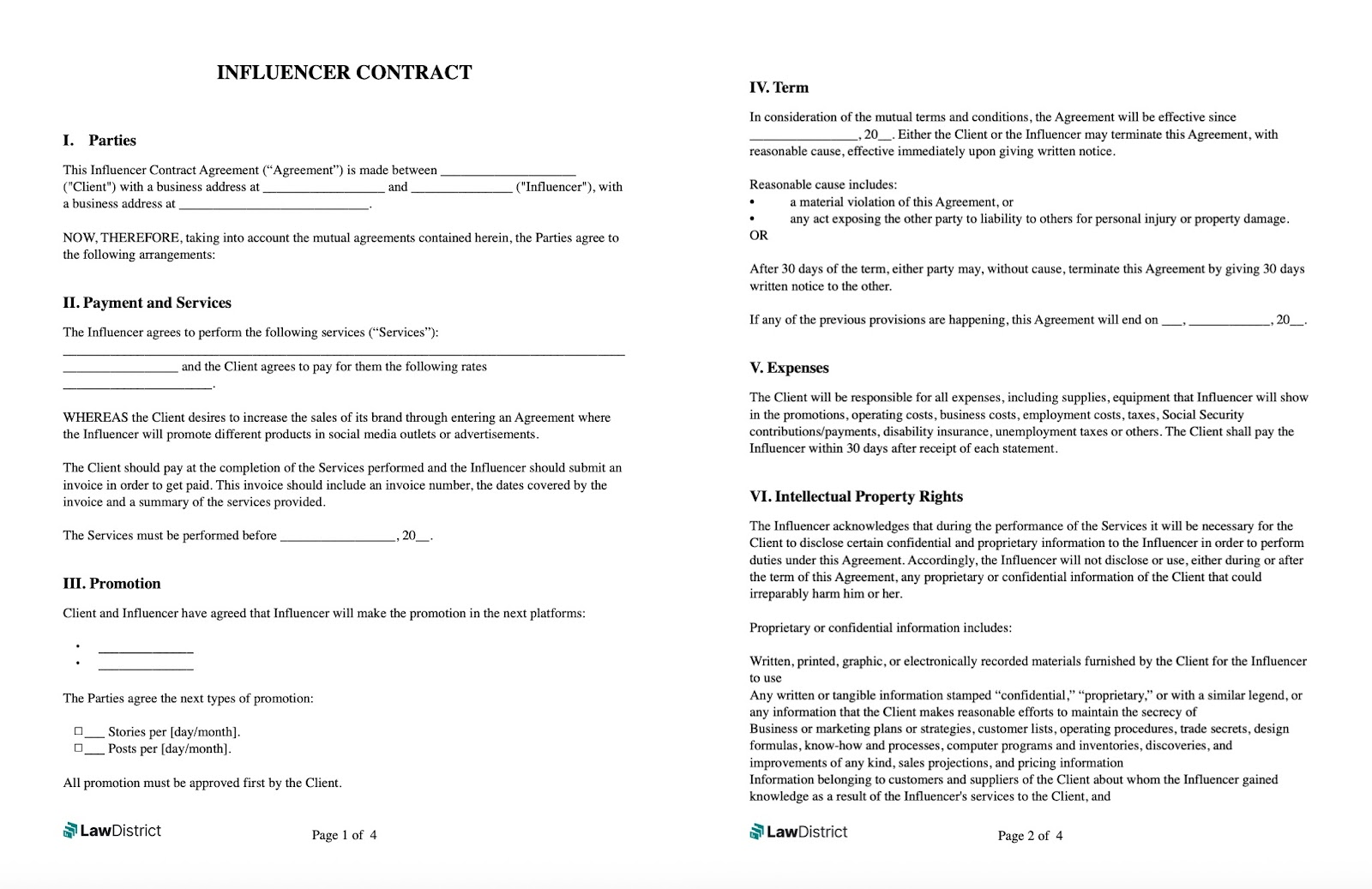
Tips for pushing back on low offers
Not every offer is worth taking. If the rate is low, the expectations are vague, or the timeline is rushed, it’s okay to ask questions or walk away. Sometimes just pushing back politely — “Can you clarify what’s included?” or “That rate is lower than what I usually charge for similar work” — is enough to open the door to a better deal.
Sometimes it’s okay to start high and meet in the middle; negotiation is part of the process, not a sign you’re asking for too much. That said, if you’re just starting out and don’t have a portfolio yet, many brands won’t be willing to pay premium rates right away. You may even need to approach the brand first.
Knowing the value of my community and seeing brands come back for repeat partnerships helped me feel confident charging what my work is worth. If a brand can't clearly explain their expectations, timeline, or wants all rights upfront for a low rate, I pause. Clear communication and mutual respect are non-negotiables for me.
{{Ciara Strickland}}
When to walk away from a brand deal
No deal is better than one that puts you or your content at risk. Sometimes the smartest move is to walk away: if the terms are unclear, there’s no contract in place, or a brand asks you to pay upfront for product or shipping — that’s a red flag.
Not all sketchy details are obvious straight away. Some scams involve brands offering vague contracts or misrepresenting affiliate campaigns as paid deals. Be cautious of unrealistic promises, ambiguous licensing terms, and emails that don’t come from verified domains.
The only red flags I look for are any scams. Never pay for a product or shipping when it comes to working with a brand. And always have a contract signed before anything is created and delivered to the client. Always protect yourself when heading into partnerships with brands and READ your contracts thoroughly!
{{Jessica Camerata}}
Wrapping it up
Negotiating sponsored content doesn’t have to feel intimidating. Once you understand your value and can show it, you’re in a much stronger position to advocate for fair rates, clear terms, and respectful partnerships. Found this guide helpful? Save it for your next brand deal or send it to a creator friend who’s just starting out.
FAQ
We are here to ease your working routine
Whether you're freelancing or a full-time contractor, we simplify the working process, putting you in control.
Try it free



Freelancers and contractors work in different ways, even if the legal side looks similar. Knowing the difference matters.
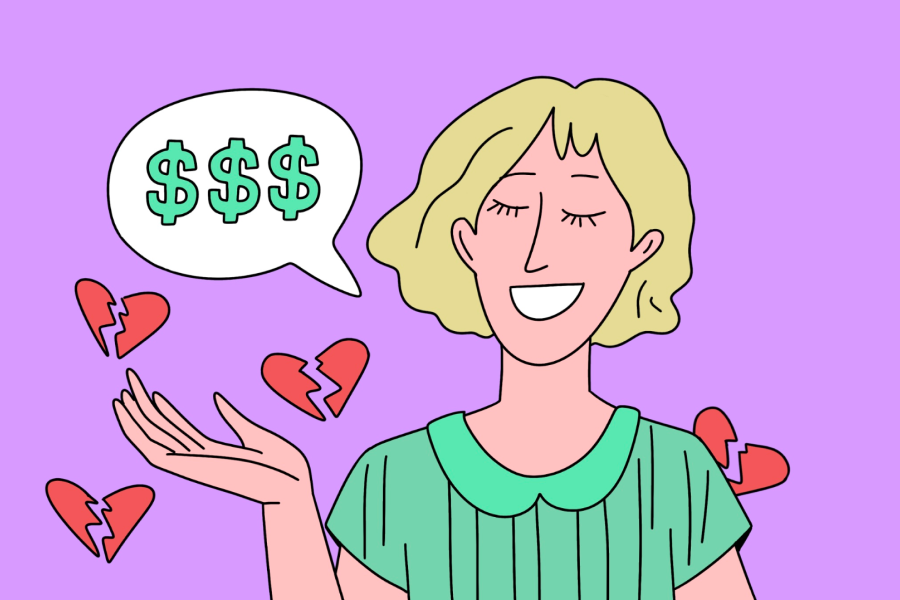
A practical guide to raising your rates and communicating the change clearly, professionally, and without unnecessary stress.

Check our guide about the best side hustles with a list of 15 second jobs at night from home for you to make more money every month.

.JPG)